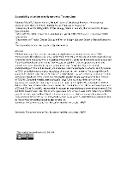Susceptibility of various sand fly species to Toscana virus

Author
Thiesson, Adrien
Arnaud, Frédérick
Stejskalová, Markéta
Rehbergerová, Markéta
Kohl, Alain
Ratinier, Maxime
Ivovic, Vladimir
Adam, Katja
Department of Biodiversity, Faculty of Mathematics, Natural Sciences and Information Technologies, University of Primorska [and] Society of Conservation Biologists (BIODIVA)
Publication date
2024Published in
ISOPS XI: International Symposium on Phlebotomine Sandflies, 9-13 September 2024, Portorož, Slovenia : Programme and Abstract BookPublisher / Publication place
University of Primorska Press (Koper, Slovenia)ISBN / ISSN
ISBN: 978-961-293-362-3Metadata
Show full item recordCollections
Abstract
Phlebotomine sand flies transmit numerous viral pathogens, including Toscana virus (TOSV, Phenuiviridae). This arbovirus is spread in the Mediterranean area and causes a wide range of clinical symptoms (from non-symptomatic to serious CNS infection). While only Phlebotomus pernicious and P. perfiliewi have been confirmed as TOSV vectors, infected or TOSV-seropositive humans and animals have been identified in regions lacking these sand fly species. Given the limited understanding of TOSV and its spread, we aimed to assess the susceptibility of other sand fly species to TOSV, potentially expanding our knowledge of its transmission in nature. The susceptibility of P. papatasi, P. tobbi, P. sergenti, and Sergentomyia schwetzi to TOSV was tested by membrane feeding with blood mixed with TOSV strains belonging to the genetic lineage A or B (referred to as TOSV-A or TOSV-B). Blood-fed females were dissected at days 4, 8, and 14 post-infection for virus quantification using both infectious viral particle titration and RT-qPCR. We show that the TOSV-A did not infect any tested sand fly species. Contrarily, TOSV-B infected P. tobbi at relatively high rates (66% and 53% at D4 and D8, respectively). Phlebotomus sergenti showed lower infection rates (5.5%) but 100% dissemination rate. Phlebotomus papatasi and S. schwetzi were 100% refractory to TOSVB. Overall, our data indicate that P. tobbi is highly susceptible to TOSV and potentially serves as the TOSV vector in the Eastern part of the Mediterranean basin, when P. sergenti is less susceptible, but its role in TOSV circulation should be also considered.
Keywords
Phlebotomine sand flies, Toscana virus, infection, vector, TOSV
Permanent link
https://hdl.handle.net/20.500.14178/2794License
Full text of this result is licensed under: Creative Commons Uveďte původ 4.0 International




